![]()
![]()
![]()
Use LEFT and RIGHT arrow keys to navigate between flashcards;
Use UP and DOWN arrow keys to flip the card;
H to show hint;
A reads text to speech;
66 Cards in this Set
- Front
- Back
|
What are shells and drums made of |
Steel plates rolled to the correct curvature with thickness ranging from 6 mm to 250 mm |
|
|
What is the process of putting shells and drums together |
If the plate is thick, it is first heated and shaped into half-cylindrical sections. These sections are then welded together to form the complete cylinder. If the plate is thin, it is rolled without heating to form the cylinder from a single sheet. The adjoining edges are then welded. After the shell, or drum, is formed and welded, the ends are closed off by means of heads, or end plates which are also made from steel plates. In the case of a watertube boiler, the heads are made in a dished rather than flat shape. In the case of firetube boilers, the heads must be flat rather than dished in order that the tube ends be securely attached. Because the firetube boiler heads hold the tube ends, they are called tubesheets. |
|
|
What are the 5 basic types of welded joints |
1. Butt Joint (primary joint used in boiler fabrication) 2. Lap Joint (sometimes used in boiler fabrication) 3. Corner Joint 4. Tee Joint 5. Edge Joint |
|
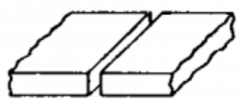
What type of welded joint is this |
Butt Joint |
|

What type of welded joint is this |
Lap Joint |
|
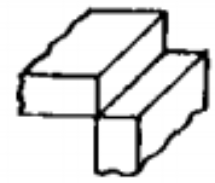
What type of welded joint is this |
Corner Joint |
|
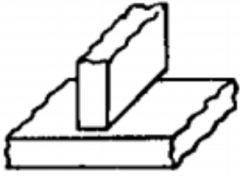
What type of welded joint is this |
Tee Joint |
|
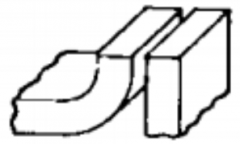
What type of welded joint is this |
Edge Joint |
|
|
What are the two basic weld types |
1. Groove Weld (used to make Butt Joints) 2. Fillet Weld (used to make Lap Joints and Tee Joints) |
|
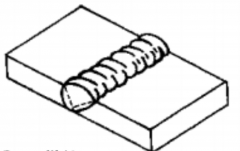
What type of weld is this |
Groove Type |
|
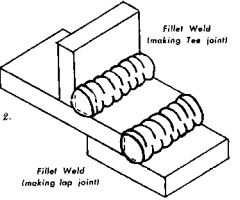
What type of weld is this |
Fillet Type |
|
|
What is a single-welded butt joint |
When the filler metal is applied from one side only |
|
|
What is a double-welded butt joint |
When the filler metal is applied to both sides of the joint. Used for thick plates. |
|

What type of weld groove is this |
Square Groove |
|

What type of weld groove is this |
V-Groove |
|

What type of weld groove is this |
U-Groove |
|

What type of weld groove is this |
J-Groove |
|

What type of weld groove is this |
Bevel Groove |
|

What type of weld groove is this |
Double Bevel Groove |
|

What type of weld groove is this |
Double Bevel |
|

What type of weld groove is this |
Double J |
|

What type of weld groove is this |
Double Vee |
|

What type of weld groove is this |
Double U |
|
|
What is a problem that must be surmounted during the welding process |
Stresses are set up in the metal due to temperature differences existing in the weld area. These stresses may be removed or reduced by heat treatment of the metal of either preheating or postheating. |
|
|
Describe Preheating |
The heating of the parts in a special oven or furnace prior to welding. Temperature ranges from 80oC to 230oC depending upon the material and thickness. |
|
|
Describe Postweld Heat Treatment |
Heat the parts after the welding has been completed. In the case of a boiler drum, after welding of the drum joints, the entire drum can be heated to a specified temperature (above 590oC) in a special furnace for a definite period of time. It is then cooled off slowly at a controlled rate until its temperature drops to below 315oC. |
|
|
What does an authorized Inspector check during the fabrication of a boiler |
- The welding procedures used by the manufacturers are correct - All welding is carried out by pressure vessel welders who are qualified to perform the required type of welding - The correct application of heat treatment is used - Test plates of the same thickness and material as the drum are welded and then subjected to tension and bending tests to verify that the drum welds will safely hold |
|
|
What are some ways that Inspectors examine boilers |
- radiograph drum welds over their entire length using x-rays or other radioactive material so that any defects within the weld can be seen on an exposed and developed radiographic film or on an electronic video screen - Use sound waves (ultrasonics) to locate and identify irregularities in a weld which are displayed on an electronic video screen |
|
|
Is riveting still used |
No, but there are still some older riveted boilers in operation |
|
|
What are the two main types of riveted joints |
1. Lap Joint 2. Butt Joint |
|
|
Describe riveted lap joints |
The edges of the plates are overlapped and fastened by one or more rows of rivets. If one row of rivets is used, the joint is single riveted; with two rows, it is double riveted. |
|
|
Describe butt joints |
The edges of the shell plates do not overlap but butt together. Cover straps are riveted to the plates covering the seam. They are used for circumferential seams in all riveted boiler shells, but longitudinal seams are nearly always of butt joint construction. Butt joints are stronger and therefore more suitable for longitudinal seams because the force tending to rupture a boiler at the longitudinal joint is greater than that at the circumferential joint. It is possible to bend the plate in the form of a true circle as the ends of the shell plate butt or meet which can't be done with lap joints. |
|
|
Describe boiler tubes made for moderate pressure service |
Tubes are made from strips of steel, which are |
|
|
Describe boiler tubes made for high pressure service |
They are usually seamless and are made by piercing a solid round billet of heated steel to form a rough tube. During piercing the heated billet is spun between rollers as it is forced against the piercing point, forming a rough tube. In the rolling operation a plug the size of the finished tube inner diameter is mounted on a long rolling rod between rollers, which are grooved to the outer dimension of the tube. The roughly shaped tube from the piercing process is then placed between the rollers, which force the tube over the rolling plug, expanding the inner diameter with the plug while reducing the outer diameter between the rollers. The tube is finally finished in a reeling operation where it is spun between smooth rollers while being forced over a smooth reeling plug to achieve final dimensions and smoothness. |
|
|
What is the most common method used to fasten tubes to drums or tube sheets |
To expand the tube ends into the tube holes in the drum or sheet. This expanding (or |
|
|
Describe watertube boiler tube expansion |
Watertube boiler tubes are expanded and flared |
|
|
Describe firetube boiler tube expansion |
Firetube boiler tubes, in addition to the expanding and flaring, have the flared part beaded over against the tube sheet. The beading of the tube end prevents it from being overheated and burned when the boiler is in service. |
|
|
What is an alternative to expansion method of tube attachment used by many high pressure watertube boilers |
Welded attachments: Boiler drums and headers have stubs welded to them in the factory; the tubes are welded to these stubs during the erection of the boiler in the field.
Some firetube boilers also use welded attachments except that the tubes are expanded both before and after the welding. |
|
|
Why is there a need for a boiler stay |
Any flat surface exposed to pressure will tend to bulge due to the effect of this pressure. To prevent this bulging from occurring, it is necessary to brace or support the flat surfaces present in the firetube boilers including the tube sheets and waterlegs and the crown sheets on the top of the furnace.
These are not normally required for watertube boilers as they can be built without flat surfaces. |
|
|
Where are diagonal stays used |
They are welded to the boiler head or tube sheet, and to the boiler shell above the tubes on a firetube boiler to allow access to the area for inspection. |
|
|
What are longitudinal/through stays |
Long rods extending from the rear tubesheet to the front tubesheet. They are usually fastened to the tubesheets by welding or using nuts and washers. Modern firetube boilers often use through stays which are stronger but allow less access. |
|
|
Where are through stays used |
The area below the tubes is often supported by through stays. |
|
|
How are stays used in packaged firetube boilers |
They usually have tubes extending to the bottom of the shell which supports the tubesheets; stays are not required in this area. Due to the need for steam space at the top of the boiler, the upper areas must be stayed. |
|
|
How are stays used in HRT Boilers |
On their rear tubesheet, the through stays are fastened by means of angle braces which distribute the stress over a large area. |
|
|
Describe staybolts |
Used primarily on steam locomotive boilers to support the boiler and the firebox. The size of bolts and the number used are determined by ASME Code. In working steam locomotive boilers, loose staybolts are one of the main causes of boiler leakage. |
|
|
Describe function of manholes/manways |
Allow entrance into drums |
|
|
Describe function of handholes |
Give access to smaller parts, such as headers and waterlegs. |
|
|
Describe shape of access openings |
Usually elliptical in shape but may be circular. Dimensions (elliptical): at least 305 mm x 406 mm Diameter (circle): at least 380 mm
Handholes: at least 70 mm x 89 mm |
|
|
What is the state of access openings during the operation of the boilers |
Closed by means of doors or cover plates. These doors, or covers, fit on the inside of the drum or header and are held in place by bolts and yoke pieces. The pressure within operational boilers help to hold the door in place. |
|
|
What do drum connections consist of |
Nozzles or stubs attached to the drum for connecting various fittings and attachments |
|
|
What kinds of things do drum connections connect to the drum |
- Safety valve - Main steam outlet - Water column - Feedwater inlet - Pressure gauge |
|
|
How are connection nozzles/stubs attached to the drum |
By welding, although on older boilers, they may be riveted. In some cases, threaded connections are screwed into the drum wall via a threaded hole, but these are restricted depending on size and pressure |
|
|
How is Code maintained while using thinner metal in the internal furnace |
It's currogated |
|

What type of furnace design is this |
Leeds Suspension Bulb Furnace |
|

What type of furnace design is this |
Fox Furnace |
|

What type of furnace design is this |
Deighton Furnace |
|

What type of furnace design is this |
Morison Furnace |
|

What type of furnace design is this |
Purves Ribbed Furnace |
|

What type of furnace design is this |
Brown Furnace |
|
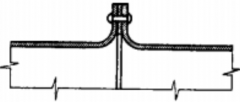
What type of furnace design is this |
Adamson Furnace |
|
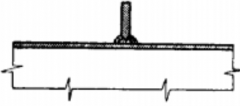
What type of furnace design is this |
Ring-Reinforced Furnace |
|
|
Why are adequate foundations and supports required |
To avoid any movement which would put extra stress on the boiler and its connecting pipework. Also, if the boiler settles at one end, the gauge glass will not five an accurate indication of the water level in the boiler.
For packaged firetube boilers, the boiler room floor must be strong enough to act as a foundation because the boiler is usually mounted on a skid type steel base. The whole assembly can then be placed directly on the floor by an overhead crane. Packaged watertube boilers are also frequently floor mounted.
For large non-packaged type boilers, it is usually necessary to provide special concrete foundations. They may be either top-supported or bottom-supported. |
|
|
Pros of Top-Supporting Large Watertube Boilers |
- Since these boilers can be 30 m or more in height and the steam drum is the heaviest part, they tend to be top heavy and unstable if bottom supported - Top support allows expansion downward as the boiler is heated, reducing stress - The structural steel used to support the boiler can also be used as the boiler house and support for other boiler auxiliaries - Since these large boilers expand by several cm when heated, top supporting is easier for attachments. Almost all of the connections on the boiler are at the steam drum when top supported, this steam drum is held in a fixed position. If bottom supported, the steam drum moves up and down with heating and cooling. For very large boilers this movement would make attachments difficult. |
|
|
Describe a watercooled wall/waterwall |
Instead of brickwork, the furnace walls of modern watertube boilers is made of adjacent tubes welded to metal fins to produce a solid panel, which is exposed to the furnace heat and backed by a layer of insulation and then an outer metal casing to protect the insulation. |
|
|
Describe a tangent-tube wall |
The inside of the furnace wall is made up of tubes which are side by side and touching each other to form a continuous surface. They are backed by a layer of plastic insulation and then a steel casing. Block insulation is then placed against the steel casing and another steel casing forms the outside surface of the wall. |
|
|
Describe a flat stud wall |
The tubes have flat studs welded to them on each side; these studs fill the space between adjacent tubes. The tubes and studs are backed up by refractory and insulation. |

